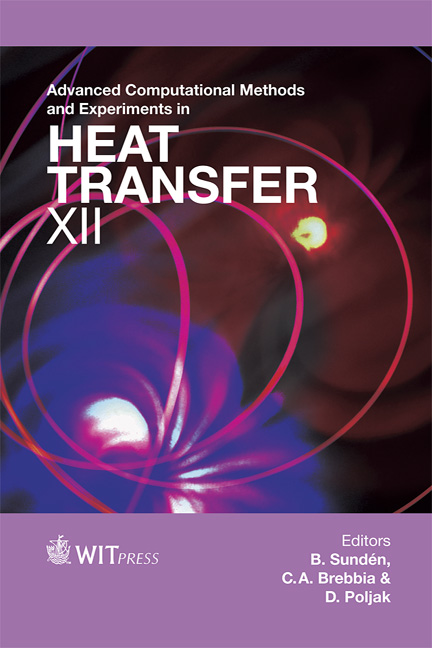Heat Transfer Characteristics For Inclined Twin-jet Impingement
Price
Free (open access)
Transaction
Volume
75
Pages
12
Page Range
169 - 180
Published
2012
Size
597 kb
Paper DOI
10.2495/HT120151
Copyright
WIT Press
Author(s)
M. Kito, T. Matsumoto, T. Shakouchi, K. Tsujimoto & T. Ando
Abstract
Determining the local heat transfer coefficient on a target surface is essential for many engineering applications. Numerous studies of the heat transfer and flow characteristics for jet impingement on surfaces have been published. However, few studies have been reported about the heat transfer characteristics of inclined, as opposed to perpendicular or normal, impinging jets. Further, few studies have been reported on twin impinging jets. In this study, local Nusselt number (Nu) distributions on the target plate were obtained for Re=5000 (based on the hydraulic diameter of the slot nozzle, Dh), the nozzle-to-plate spacing (H/Dh=2), the nozzle-to-nozzle spacing (L/Dh=3, 5 and 7) and various twin-jet angles (θ=0, 15, 30 and 45°). For θ=0°, two primary stagnation points having maximum Nu numbers appeared at the geometrical impingement points of the each jet. A secondary stagnation point occurs in the mid-point between jets at L/Dh=5 and 7. However, the secondary stagnation disappeared at lower nozzle-to-nozzle spacing (L/Dh=3) .The primary Nu peak shifts away from the geometrical impingement point and the value of the primary Nu peak decreased as the inclination angle increased. When two jets were inclined in the same direction, the decrease in the first peak was smaller than that in the second peak with the increasing angle of the jets. On the other hand, the values of both peaks’ Nu were almost the same when two jets were inclined to face each other. Keywords: heat transfer, inclined twin jets, jet cooling, turbulent flow, slot jet nozzle.
Keywords
heat transfer, inclined twin jets, jet cooling, turbulent flow, slot jetnozzle.





